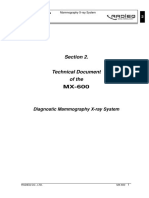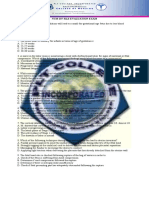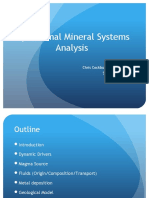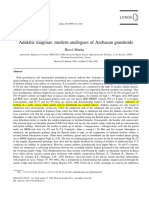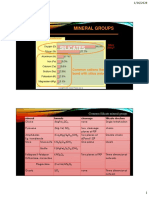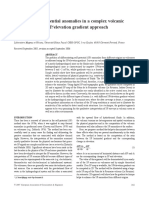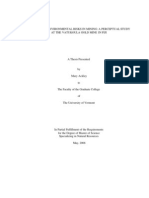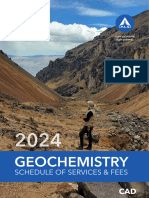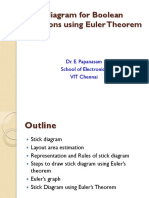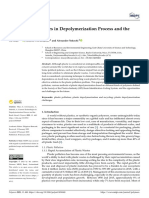The Canadian Mineralogist
Vol. 54, pp. 917-933 (2016)DOI: 10.3749/canmin.1600010
A TECTONIC EVALUATION OF PEGMATITE PARENT GRANITES
S
ARAH
L. HANSON
Adrian College, Geology Department, 110 S. Madison St., Adrian, Michigan 49221, USA
A
BSTRACT
Pegmatites containing rare elements can be grouped into families based on geochemical composition. The familyclassification includes pegmatites that are enriched in lithium, cesium, and tantalum (LCT pegmatites) and those that areenriched in niobium, yttrium
þ
rare-earth-elements (REE), and fluorine (NYF pegmatites). A small number of pegmatites donot fall neatly into these categories and include (1) those that exhibit mineralogical and chemical characteristics of both groups(mixed LCT
þ
NYF pegmatites) and (2) those that lack one of the chemical components suggested by the acronyms. Therelationship between pegmatite family and granite tectonic type were re-examined using a large data set of published granitecompositions as a proxy for initial pegmatite composition, with special regard to the orogenic settings of the source graniteorigin. Pearce trace-element discrimination diagrams for these granites suggest that LCT granite-pegmatite systems originate inorogenic and perhaps less frequently in post-collisional tectonic settings, whereas NYF pegmatites form in anorogenic and post-orogenic settings. Geochemical differences in the granite from each tectonic setting are reflected in the pegmatite mineralogy.Granite that is parental to LCT pegmatites has generally higher abundances of LILE and B, thus the pegmatites typicallycontain Li-bearing and Cs-bearing minerals as well as tourmaline group minerals. In contrast, granite that is parental to NYF pegmatites is typically enriched in the REE and HFSE
6
F, thus typically have accessory Nb-Ta-Ti oxides, REE-bearingminerals, and in most cases fluorite. These petrogenetic differences hold for the quintessential LCT and NYF pegmatites as wellas for those that have notable absences of one of the principle components.Mixed-signature pegmatites that can be attributed to a parental granite are rare. For the three locations included in thisstudy, a post-orogenic to anorogenic origin suggests that these pegmatites may have been broadly NYF systems that werecontaminated at the magmatic stage or hydrothermally altered by a fluid enriched in components representative of LCT pegmatites.
Keywords
: pegmatite, NYF, LCT, Pearce discrimination diagram, parent granite, tectonic origin.
I
NTRODUCTION
The most widely cited classification system for pegmatites is based on crystallization depth and categorizes pegmatites from deepest to shallowest asabyssal, muscovite, muscovite-rare-element, rare-ele-ment, and miarolitic (ˇCern´y & Ercit 2005). Theseauthors also suggest a family classification system thatdistinguishes pegmatites derived by fractionation of agranitic melt based on petrogenetic parameters.Pegmatite families for the rare-element and miaroliticclasses are subdivided into pegmatites that areenriched in lithium, cesium, and tantalum (LCT pegmatites), and pegmatites that are enriched inniobium, yttrium
þ
rare-earth-elements (REE), and fluorine (NYF pegmatites). It is important to note thatthe above family classification applies only to pegmatites that are derived
via
fractional crystalliza-tion of a parent granite. Recent studies (Martin &DeVito 2005, Hanson
et al
. 2013, McKechnie
et al
.2012) have shown that anatectic pegmatites, those thatresult from partial melting of either crustal or mantlerocks, may be more common than previously thought.The number of pegmatite studies has increased significantly since these pegmatite families were first proposed by ˇCern´y (1991). With more detailed information on a much larger number of pegmatites,it has become increasingly apparent that some pegmatites do not fit neatly into the LCT and NYFfamilies. The most common difficulty arises from pegmatites that exhibit a distinctly mixed LCT
þ
NYFsignature. Further complicating the family classifica-
§
Corresponding author e-mail address
: slhanson@adrian.edu
917
tion are pegmatites, and even pegmatite districts, thatdo not exhibit enrichment in all three of the elementstypical of the designated family (ˇCern´y & Ercit 2005).For example, although the Trout Creek Pass pegma-tites contain accessory Nb-Ta-Ti oxides and REE- bearing minerals, fluorine-bearing minerals are sparseand fluorite is notably absent in both the extensivequarries and in the dump material (Hanson 1990,Simmons
et al
. 2012). This assemblage of accessoryminerals suggests that these pegmatites are enriched in Nb and Y, but with notably low F content they are nottypical NYF pegmatites (Hanson 1990, Hanson
et al
.1992).Early work on pegmatite classifications indicated affiliations of different pegmatite families to their parent granite type (S-, I-, and A-types) and tectonicenvironment (syn-, late-, post-orogenic, and anoro-genic) but noted that there were
‘‘
significant and widespread exceptions
’’
(ˇCern´y & Ercit 2005 and references therein). A subsequent study by Martin &DeVito (2005) proposed that there exists a strongrelationship between tectonic setting and pegmatitetypes. Based on geochemical constraints, these authorssuggested that LCT pegmatites result from magmatismin compressional (orogenic) settings, whereas NYF pegmatites develop in extensional (anorogenic) set-tings. These authors further noted that this
‘‘
proto-tectonic
’’
classification for pegmatites would be moreconsistent with the current classification of granite,which is based on geochemical constraints.Quantitative analysis of pegmatites is difficult because the extremely coarse grain size of someminerals, as well as the internal zonation of the pegmatites, precludes a direct measurement of both themodal abundance of minerals and whole rock chemistry. Further complications in evaluating themineralogy of zoned pegmatites arise when only a portion of the pegmatite is exposed. Thus, the list of minerals present may be incomplete and the modal proportions of these minerals may not be representa-tive of the pegmatite as a whole. Both of these factors preclude a direct measurement of the whole rock geochemical composition for pegmatites. For thesereasons, this study evaluated the tectonic origin of LCT–NYF family pegmatites in well-constrained granite-pegmatite systems where pegmatites formed
via
fractional crystallization of a parent granite. The parent granite compositions were used as a proxy for the initial pegmatite composition of the resultingfractionally crystallized pegmatite. The purpose of this paper is not to address the pegmatite classificationsystem, but instead to evaluate the tectonic origin of LCT and NYF pegmatites in the overall context of petrogenesis of granite pegmatites that form
via
fractional crystallization of granite.
O
ROGENIC
, A
NOROGENIC
,
AND
P
OST
-O
ROGENIC
G
RANITES
Orogenic granitic plutons form in tectonic settingsthat range from subduction to continental collision.They generally produce granite that is either I- or S-type, derived from melting of igneous or sedimentaryrocks, respectively. In subduction zones, water re-leased from the downgoing slab carries high concen-trations of large ion lithophile elements (LILE) and B, but leaves behind the relatively insoluble high field-strength elements (HFSE). This leads to an enrichmentof the more soluble elements in the overlying mantlewedge. Subsequent melting of this metasomatized mantle material produces magma that is enriched inLILE and B. These melts can accumulate at the base of the crust where assimilation and fractional crystalli-zation processes modify the magma to more siliciccompositions. Additionally, this can lead to melting of overlying lower crustal material. In both cases, theresulting suite of granitic rocks is generally metal-uminous and exhibits a calc-alkaline enrichment trend.If assimilation of crustal material is significant, theserocks may show a strong imprint of an S-typecomponent. In continent–continent collisional settings,crustal thickening and heating produces anatectic S-type granites that are generally strongly peraluminous,although some may be weakly metaluminous. How-ever, S-type granites older than 1.5 Ga that werederived from metasedimentary protoliths still possesstheir primordial mantle characteristics, thus will bemetaluminous rather than peraluminous, in spite of theimportant role of metasedimentary rocks at the source(Valley 2003, Martin & De Vito 2005).Anorogenic granitic plutons result from melting atlocations where extension and associated attenuationof the crust is the dominant tectonic process. Extensioncan occur during periods of tectonic quiescence on aregional scale or be more localized, the result of back-arc spreading or transtension when the collision isoblique. Thus, localized extension can occur in a broadly regional collisional tectonic setting. Graniteformed in extensional tectonic settings is referred to asA-type granite. These granites exhibit variable chem-ical signatures but typically are enriched in HFSE, areoften Fe-enriched, and are metaluminous to mildly peralkaline. Frost & Frost (1997) suggested thatextensional environments where the asthenosphere isat shallow levels will produce granites of varied composition, the result of the relative contribution of fractionated tholeiitic magmas and felsic continentalmaterial. The tholeiitic magmas are derived fromeither extreme differentiation of basaltic melts or by partial melting of underplated basalts and their differentiated equivalents. These authors further sug-918
THE CANADIAN MINERALOGIST
gested that if the crustal component is minor, reduced rapakivi granite will form (
e.g
., Sherman and Wolf River Batholiths). If the material contains substantialfelsic crust as well as underplated crust, a wider rangeof compositions including metaluminous magnetite- bearing granitic rocks will be present. Lastly, associ-ated partial melting of metasedimentary rocks will produce peraluminous granite such as those commonlyseen in the southwestern U.S.Post-orogenic, or post-collision, granites representa poorly defined category of plutons emplaced duringthe transitional period subsequent to an orogenicevent. Pearce (1996) suggests that the boundary between post-collision and anorogenic conditionsoccurs when magmatism ceases to be linked toorogenic processes, a boundary which is difficult toidentify. Post-orogenic granites range from A- to I-type in character and, because of the transitionaltectonic setting, exhibit chemical characteristics thatare transitional between orogenic and anorogenicgranites. They range in composition from weakly peraluminous to weakly metaluminous (Thompson &Barnes 1999).
M
ETHODS
Data were mined
via
an extensive literature searchin an effort to provide whole rock major and traceelement data for granites that are parental to well-characterized pegmatites. Only pegmatites that wereconvincingly attributed to a parental granite wereincluded in this study and include 16 LCT pegmatites,24 NYF pegmatites, and three mixed LCT-NYF pegmatites. The pegmatite locations are given inTable 1 and the accessory mineralogy in Table 2.Potential sources of error when classifying pegmatites based on parental granite compositions include theincorrect identification of a pegmatite parent graniteand poor resolution of geochemical data, a problemthat is greater with older data.
D
ISCRIMINATION
D
IAGRAMS
A comparison of the relative molar abundances of the alkali elements
versus
aluminum shows significantoverlap for granitic rocks from different tectonicsettings. In orogenic settings, I-type granite isgenerally metaluminous, whereas S-type granite(
,
1.5 Ga) is peraluminous to weakly metaluminous.Anorogenic granites can be metaluminous to mildly peralkaline. Post-orogenic granite is generally weakly peraluminous to weakly metaluminous. Similarly,granite that is parental to LCT and NYF pegmatitesexhibits this overlap (Fig. 1). In general, granites thatare parental to LCT pegmatites are peraluminous,whereas those that are genetically related to NYF pegmatites range in composition from peraluminous tometaluminous. This compositional overlap may, in part, be the result of variable amounts of crustal
versus
mantle components that comprise anorogenic, and particularly post-orogenic, magmas. It is apparentfrom this diagram that the aluminum saturation indexis not a good tectonic discriminator for granites, and thus it is not a reliable method for differentiating thetectonic origin of pegmatites derived from fractionalcrystallization of granite.Tectonic discrimination diagrams based on wholerock trace-element compositions are considerablymore effective in determining the petrogenetic originfor granite (Pearce
et al
. 1984, Pearce 1996). Averaged granite trace element compositions for all of thelocations included in this study are shown in Figure2a–c. The fields shown represent tectonic environ-ments and include orogenic and anorogenic granites.Orogenic granite can be subdivided into subduction-related volcanic arc (VAG) and collision-related (syn-COL) granite. Anorogenic granite includes those thatform in within plate (WPG) and mid-ocean ridge(ORG) tectonic settings. F¨orster
et al
. (1997), usingdata from over 250 locations with known tectonicsettings, evaluated the accuracy of the Rb
versus
Nb
þ
Y diagram in identifying the tectonic setting. Theseauthors concluded that the granitic rock trace elementconcentrations correlated
‘‘
to a considerable extent
’’
with tectonic setting but should be used judiciouslyand consider the nature of the source rock, especiallyin complex tectonic settings. Several areas of greater potential error were noted. First, there was an extremeoverlap within the specific types of orogenic granites(WPG and VAG). Second, the post-orogenic (post-COLG) granite field, which lies within the oval inFigure 2, compositionally overlaps portions of the syn-COLG, VAG, and WPG granite fields. This is likely because of the transitional nature of these granites asthese at least partially mantle-derived magmas have been modified by significant crustal assimilation, and therefore contain components of both orogenic and anorogenic granites (Pearce
et al
. 1984). Furthermore,these granites are chemically similar to those formed in back-arc extensional regimes (F¨orster
et al
. 1997).Thus, it is possible to have granite with an anorogenicsignature derived from a localized zone of extension ina broadly compressional tectonic regime. For thisreason other techniques, such as general geology, agedating, or isotopic studies, may be required todetermine if a pluton is post-orogenic, anorogenic, or results from localized extension in a compressionaltectonic regime.It is apparent from the Pearce discriminationdiagrams (Fig. 2a–c) that orogenic granites aredepleted in Nb
þ
Y relative to anorogenic granites.
A TECTONIC EVALUATION OF PEGMATITE PARENT GRANITE
919
TABLE 1. GRANITE-PEGMATITE LOCATIONS INCLUDED IN THIS STUDYPegmatite Location Host Granite References
LCT Pegmatites
Kings X, Wisconsin, USA Hoskin Lake Granite Richardson 1998McAllister pegmatite, Alabama, USA Rockford Granite Foord & Cook 1989S. Maine pegmatites, USA Sebago Pluton Wise & Brown 2010Brown Derby, Colorado, USA Quartz Creek Granite Elder 1988San Diego Co., California, USA Peninsular Ranges Batholith Silver & Chappell 1988Black Hills, South Dakota, USA Harney Peak, Calamity PeakgranitesDuke
et al
. 1992Red Cross Lake, Manitoba Canada Unnamed leucogranite
ˇC
ern
´y
et al
. 2012Mavis Lake Peg. Group, Ontario,CanadaGhost Lake Batholith Breaks & Moore 1992NW Quebec pegmatites, Canada Lamott & Lacorne plutons Mulja
et al
. 1995, Mulja
et al
. 1996Pinilla de Fermoselle, Zamora, Spain Two-mica leucogranite Roda-Robles
et al
. 2012Elba, Italy Monte Capan Dini
et al
. 2001Varutr
¨a
sk pegmatite, N. CentralSwedenH
¨a
rn
¨o
granite Claesson & Lundqvist 1995,
ˇC
ern
´y
et al
. 2004High Himalaya, Nepal Manaslu granite LeFort
et al
. 1987,
ˇC
ern
´y
1991Stak Nala, northeast Pakistan Nanga Parbat-HarmosaleucogranitesGeorge
et al
. 1993, Laurs
et al
. 1998Koktokay
#
3 pegmatite, NW China Keketuobai Granite Zhang
et al
. 2008, Zhu
et al
. 2005Sierras Pampeanas, northwestArgentinaAchala Granite Complex Morteani
et al
. 1995
NYF Pegmatites
Mount Antero, Colorado, USA Mt. Princeton Pluton; Mt. AnteroInt.Shannon 1988South Platte, Colorado, USA Pikes Peak Batholith Simmons
et al
. 1987, Simmons
et al
.1999Lake George, Colorado, USA Pikes Peak Batholith Smith
et al
. 1999Mt. Rosa/Stove Mtn., Colorado, USA Pikes Peak Batholith / Mt RosaGraniteSmith
et al
. 1999Trout Creek Pass District, Colorado,USAUnnamed granite Hanson 1990, Hanson
et al
. 1992Mojave District, Arizona, USA Unnamed granite dikes Brown 2010Searchlight Dist., Nevada, USA Bat Ears & S. Ridge granites Masau 2003, Bachl
et al
. 2001Barringer Hill, Llano, Texas, USA Lone Grove Pluton Ehlmann
et al
. 1964, Smith
et al
. 2010White Mts., New Hampshire, USA Conway Granite Eby
et al
. 1992, Camp 2011Wausau Complex, Wisconsin, USA Wausau Complex plutons Falster
et al
. 2012Bokan Mountain, Alaska, USA Bokan Mountain Complex Dostal
et al
. 2013Antigonish Highlands, Nova Scotia,CanadaGeorgeville Pluton Murphy
et al
. 1998McKeel Lake, southwest NewBrunswick, CanadaWestford Intrusion Seidler
et al
. 2005Serie dei Laghi, southwest Alps, Italy Baveno Granite Boriani
et al
. 1992, Pezzotta
et al
.1999K
¨o
nigshain, Germany K
¨o
nigshain granite, LusatianComplexThomas
et al
. 2009, Hect
et al
. 1999Evje-Iveland, Aust-Agder, Norway H
¨o
rvingston Complex Pederson & Konnerup-Madsen 1999Tysfjord, Norway Tysfjord Granite Romer
et al
. 1992Ytterby, Sweden Fellingsboro Granite Eliason & Sch
¨o
berg 1991Jharsugda, India Jharsuguda Granite Kumar
et al
. 2001Naegi, Japan Naegi Granite, biotite granite Takafumi & Kawbe 2003, Ishihara &Wu 2001Klein Spitzkoppe, Namibia Klein Spitzkoppe Stock Haapala
et al
. 2007Erongo Mountains, Namibia Erongo Granite (Boulder Forest) Boudreaux 2014
920
THE CANADIAN MINERALOGIST





